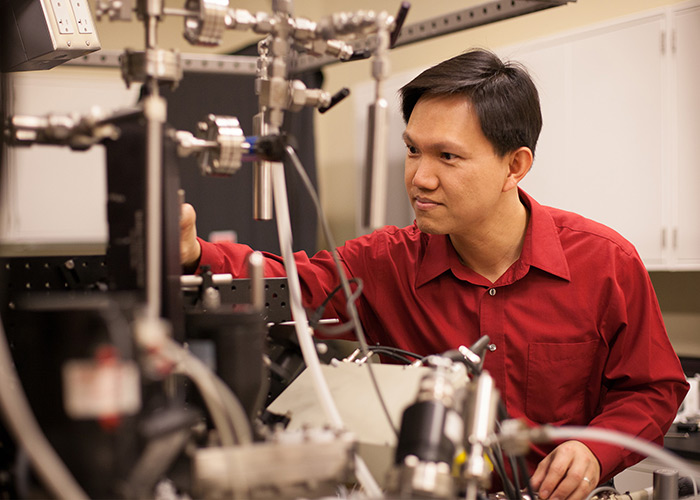Imaging Molecules in Motion
“At the interface where different materials meet, molecules can behave in some very unique ways,” said Ding-Shyue (Jerry) Yang, assistant professor of chemistry at the University of Houston. “My research observes this behavior.”
 Ding-Shyue (Jerry) Yang, assistant professor of chemistry, is the recipient of a prestigious
NSF CAREER Award.For this research, Yang was awarded a prestigious five-year, $570,000 National Science
Foundation (NSF) CAREER Award. These awards are granted to highly promising junior
faculty members who exemplify the role of teacher-scholars through “outstanding research,
excellent education and the integration of education and research.”
Ding-Shyue (Jerry) Yang, assistant professor of chemistry, is the recipient of a prestigious
NSF CAREER Award.For this research, Yang was awarded a prestigious five-year, $570,000 National Science
Foundation (NSF) CAREER Award. These awards are granted to highly promising junior
faculty members who exemplify the role of teacher-scholars through “outstanding research,
excellent education and the integration of education and research.”
Temporal Resolution to Image Molecular Motion
One of the keys to observing the behavior of molecules is a question of having the right temporal resolution. Similar to the difference between high-speed photography and regular photography, the challenge is to have a shutter speed that can capture a sharp image of a moving object. Without the right shutter speed, the photo will come out blurry.
Imaging molecular motion requires resolution on a timescale of femtoseconds, a quadrillionth of a second, or picoseconds, a trillionth of a second. There are no mechanical shutters that can capture those kinds of speed. Instead, Yang’s lab relies on a technique known as ‘pump-probe.’
Perturbing Molecules to Measure Response
“With the ‘pump-probe’ methodology, we perturb the molecules by a pump pulse, and then send out an interrogating probe pulse to ask ‘What are you doing and where are you?’” said Yang, who is a faculty member in the College of Natural Sciences and Mathematics. “It’s like a ‘Q&A,’ when you ask a question and get an answer. We provoke the molecules to see how they respond.”
The study of chemical reactions and molecular motions was first pioneered by Yang’s Ph.D. advisor, the late Ahmed Zewail, who was a professor at the California Institute of Technology. In 1999, Zewail received the Nobel Prize in Chemistry for this work using femtosecond pump-probe spectroscopy.
However, to visualize collective molecular motions and behavior at an interface, direct structural images are more helpful than spectroscopic signals, which only offer indirect information. This difference is analogous to seeing an actual photo versus obtaining a histogram that offers statistics on the color and intensity information collected from the entire image.
The second key to Yang's research is that by using high-energy electrons as a probe, he can capture structural images with the right spatial resolution at the molecular level.
Yang has accomplished two new pump-probe techniques by combining a femtosecond laser with reflection high-energy electron diffraction and scanning electron microscopy. Taken together, these can visualize the motion of molecules at the interface of two different materials.
Each interrogating pump-probe event captures a snapshot of molecules at a single moment in time. Just like with a cartoon, which is made using sequential images, assembling a sequence of these molecular snapshots provides Yang’s research group with information about how these molecules move and interact with each other and with the supporting surface.
“Using ultrafast electron imaging methods, we can take advantage of an electron’s wave-particle duality, which gives us the spatial resolution we need,” Yang said.
Understanding Behavior of Molecules at Boundaries Applicable to Industry
Yang’s research will examine the interaction between different molecules and solids with different surface affinities. Although this question is a basic one, the answers promise to have offshoots into many different applications.
“The fundamental understanding of the unique properties of molecular behavior at interfaces is a question that has relevance in heterogeneous catalysis, electrochemistry, nanotechnology and lubrication, because all of them involve molecules at surfaces,” Yang said.
Outreach to Local High School Students
In addition to this research, Yang will conduct outreach to local high school students, serving as the local coordinator for the Chemistry Olympiad Competition, as well as conducting on-site tours of his lab for school visits.
“By giving lab tours to high school students, I hope to expand their view of what chemistry is about,” Yang said.
- Rachel Fairbank, College of Natural Sciences and Mathematics